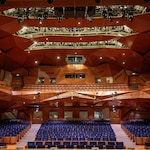Music and Movement - Active Field Control Brings Music and Dance Together -
-
Live Events
-
Live Sound & Event Production
Let's Dance With The Orchestra! was a unique collaboration of live dance and orchestral music, staged at the Kani City Cultural and Creative Center, in Japan’s Gifu prefecture. Yamaha’s AFC Enhance and AFC Image immersive audio solutions ensured that the audience, dancers and musicians all enjoyed the best possible sound.
Kani City Cultural and Creative Center (or ‘ala’) is a socially-inclusive cultural hub which hosts a wide array of events, many involving local people. Let's Dance With The Orchestra! was the 13th of its large-scale citizen participation projects, which brought 50 amateur dancers and the Kani Symphony Orchestra together to create a one-of-a-kind world, fusing classical music with contemporary dance.
Masako Yasumoto, widely renowned in Japan as a dancer, stage choreographer and music video performer, choreographed and directed the performance, with Seiichi Kotani conducting the orchestra. The programme featured John Williams’ Theme From Star Wars and Dvorak’s Symphony No. 8 in G major.
THE CHALLENGE
“The venue’s main theatre is designed for stage plays and has a short reverberation time of around 1.6 seconds, with the use of acoustic reflectors,” says Mr. Hayato Ikeda, chief sound engineer of the venue’s Stage Technology Section, who was in charge of the sound system.
As well as being unusual in combining an orchestral performance with contemporary dance, the production featured two scenes - one with the orchestra pit in its usual lowered position, but at first with it raised to stage level.
“We wanted the audience to see the musicians during the prologue section, where there was no dancing,” says Mr Ikeda. “Then, during the dance scenes, it was lowered to its usual position so the audience could see the dancers.”
The show setup meant it would be difficult to use the hall’s acoustic reflectors, while the curtain-based set also absorbed sound. All of these factors all meant that the rich quality of orchestral music would be compromised. Using Yamaha AFC Enhance and AFC Image meant that the audience, dancers and musicians alike would enjoy much improved sound.
THE SOLUTION
Yamaha Active Field Control (AFC) is a comprehensive sound space control system with two functions. AFC Enhance controls spatial resonance, while AFC Image locates the positions of sounds within the acoustic space.
The venue has a Dante-compatible digital audio network infrastructure installed throughout, meaning the AFC systems could be based on this network, with less logistical challenges and installation time for Mr Ikeda and his technical team.
For the AFC Enhance system, two rows of four microphones were suspended from the ceiling to collect the sound. This was used to improve the natural reverberation of the space by being re-broadcast through speakers which are permanently installed around the auditorium.
“Once we had set the AFC Enhance system up, we first created a basic setting, then perfected the sound by making fine adjustments. Even with the coarse setting it sounded very good. The sound was so natural that turning off the AFC Enhance system made me feel uncomfortable,” says Mr Ikeda.
“The sound changed considerably between when the orchestra pit was up and when it was down. Because of this, we created presets optimized for each scene.
We then created a bespoke control screen in Yamaha’s ProVisionaire software, allowing us to control the presets and reverberation intensity from an iPad in real time during the performance.”
As well as using AFC Enhance to improve the venue’s acoustics, Mr Ikeda used AFC Image to reinforce the sound of the orchestra. He had previously used it at the venue in 2022 and 2023 for the annual Takeo Moriyama Jazz Night concert and was very impressed.
“We mainly used it to reinforce the sound of the strings, especially in areas when the orchestra pit was lowered and it was difficult for the sound to reach the audience,” he says. “A normal PA uses two channel, left-right panning, but AFC Image can accurately plot all microphones placed in the orchestra pit and on the stage as objects in the three-dimensional sound space. This allowed us to place each sound more accurately, according to the instrument’s location, than with a normal PA.”
37 microphones were placed in the orchestra pit, plus seven boundary microphones on the stage. The inputs were routed via Rio3224-D and Rio1608-D I/O racks to a Yamaha QL5 digital mixer for balancing, before being sent to the AFC Image processor. The output signals for both AFC Enhance and AFC Image, along with non-AFC feeds, such as the master of ceremonies, were routed and EQd by a Yamaha DME7 signal processor and sent to the power amplifiers for the auditorium speakers.
Because the AFC system was also being used to enhance the sound field for the dancers, NEXO P8 and PS10 speakers were installed above and on each side of the stage. The sound for these was mixed on a Yamaha CL5 digital mixer.
Another big advantage of using AFC Image was its built-in 3D reverb. “We used the 3D reverb because it calculates distance compensation and optimal reverberation for all speaker positions, so you get a natural sound, as if the space is really resonating. The reverberation itself is very high quality, with good sound separation and presence,” says Mr Ikeda.
Having discussed the use of the AFC systems with the orchestra’s conductor Seiichi Kotani before the event, and immediately receiving a positive response, Mr Ikeda was very pleased that the musicians, dancers and audience alike were very pleased with the sound of the performance. “Everyone was very impressed with the results,” he says.
“I hope that Yamaha will continue to develop new sound technologies, like the AFC system, which sound engineers cannot yet imagine,” he says. “With Yamaha, I have high expectations for the future of live sound.”
Choreography/Direction: Masako Yasumoto
Conductor: Seiichi Kotani
Art Director: Hiroko Oshima
Assistants: Masashi Koyama, Emi Ogura
Location
Gifu, Japan






































